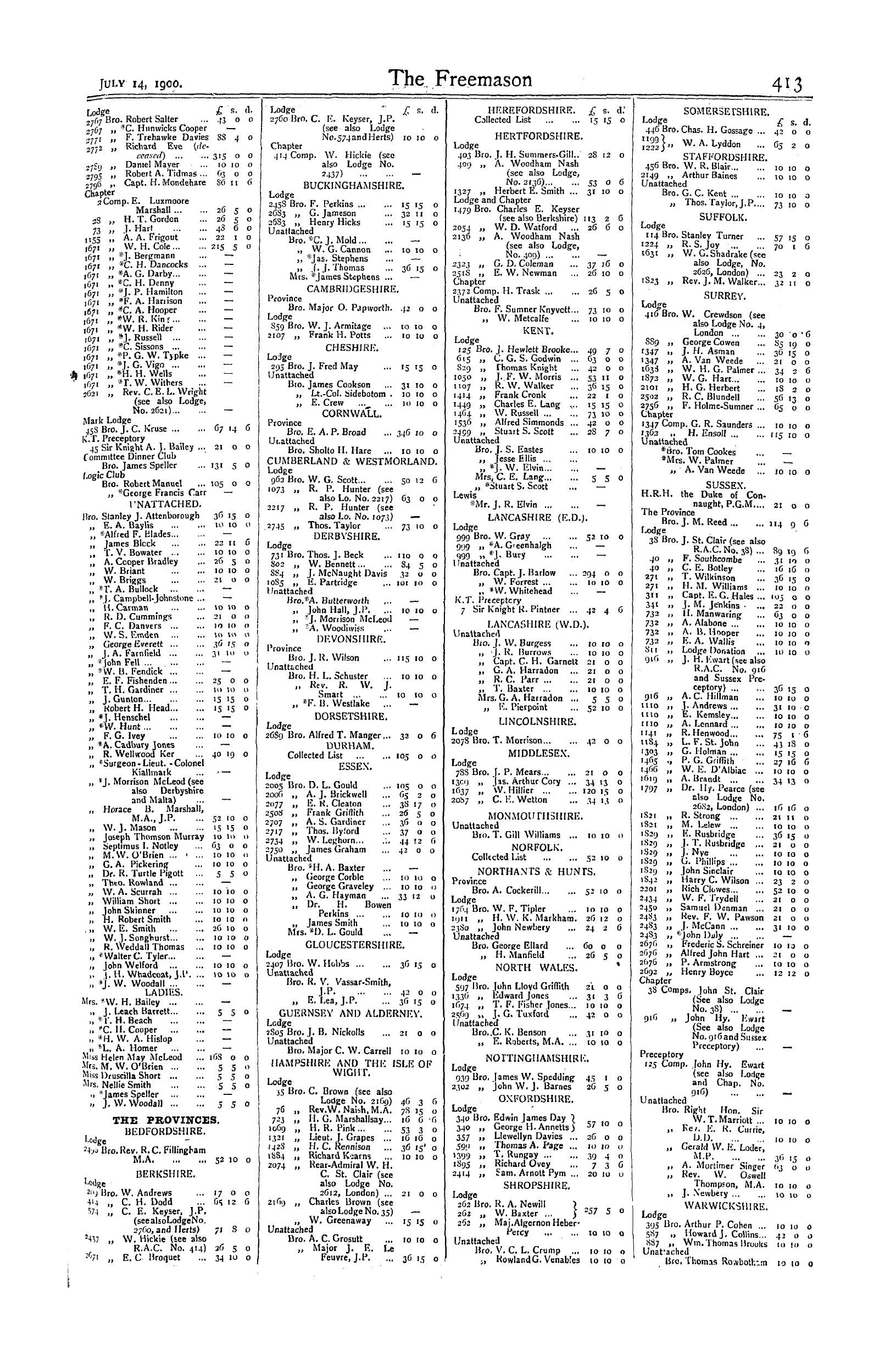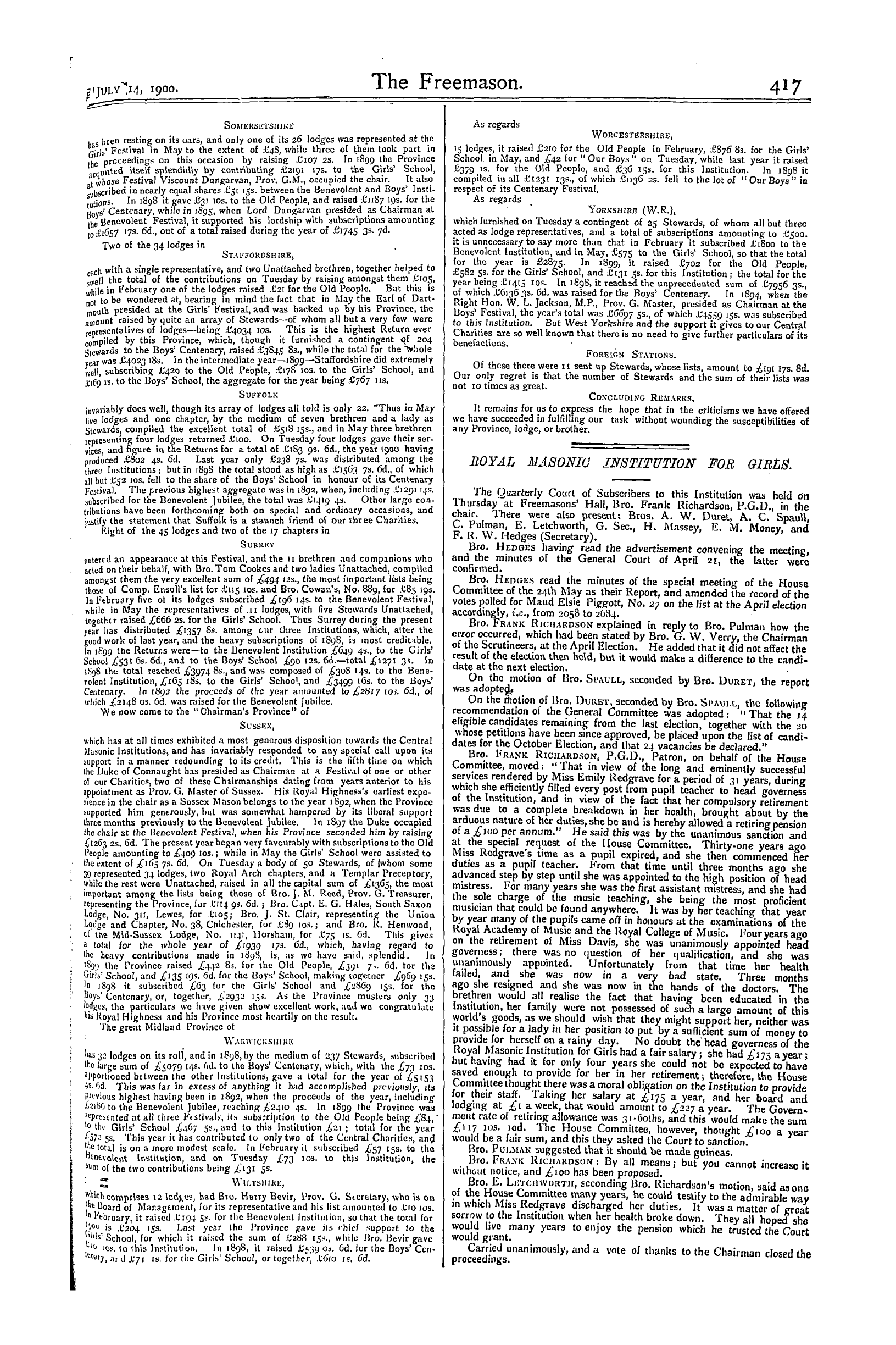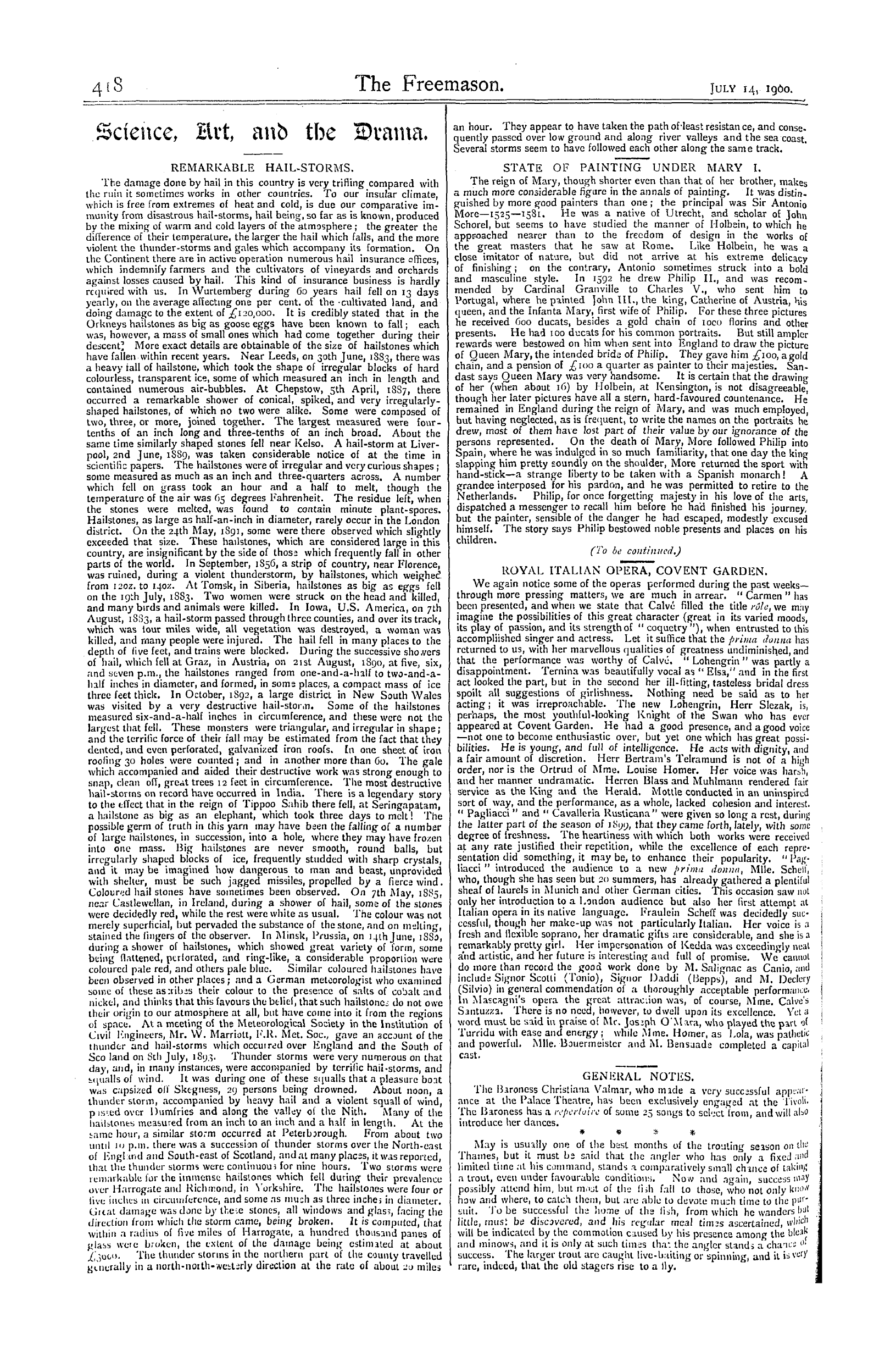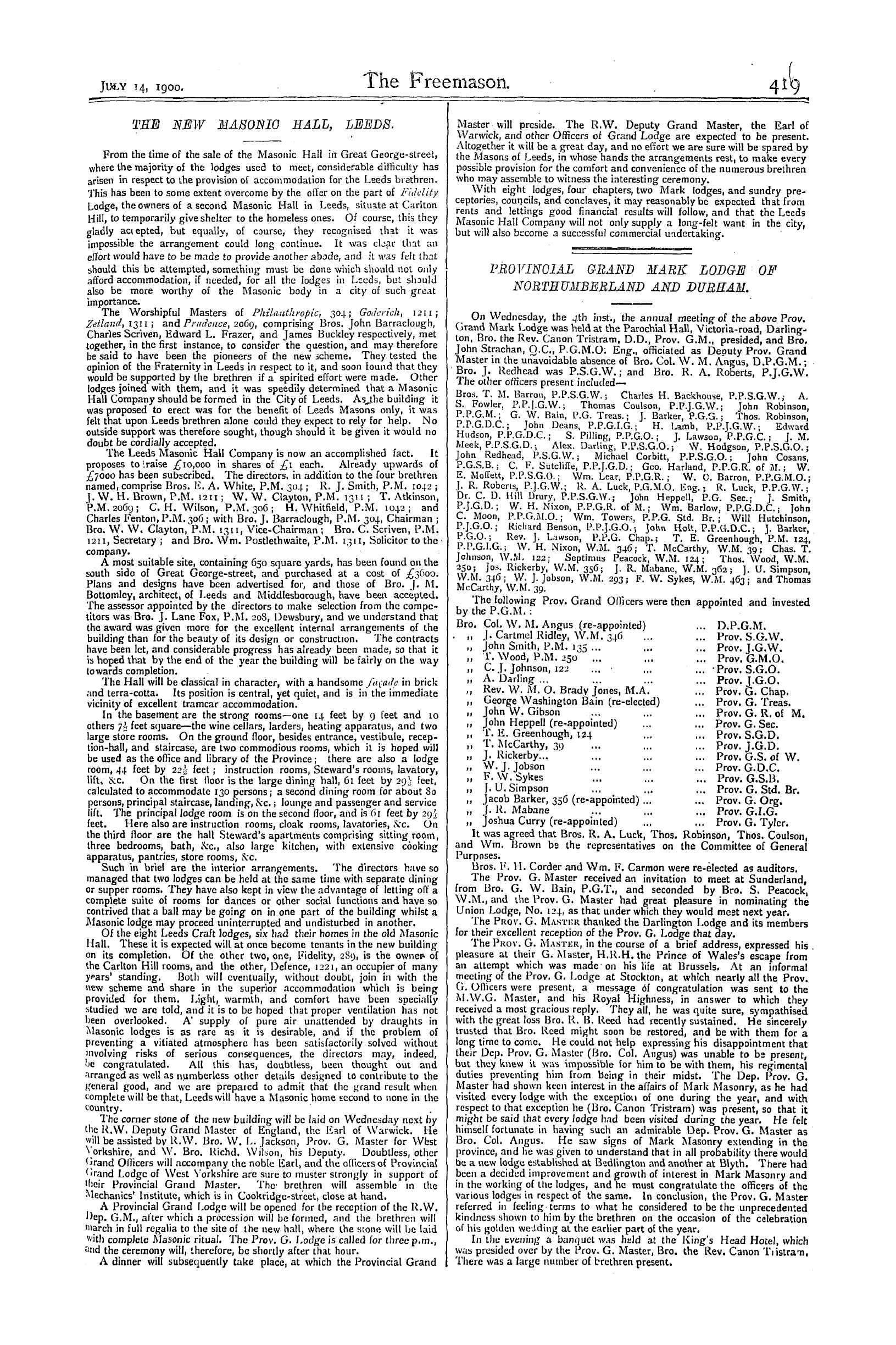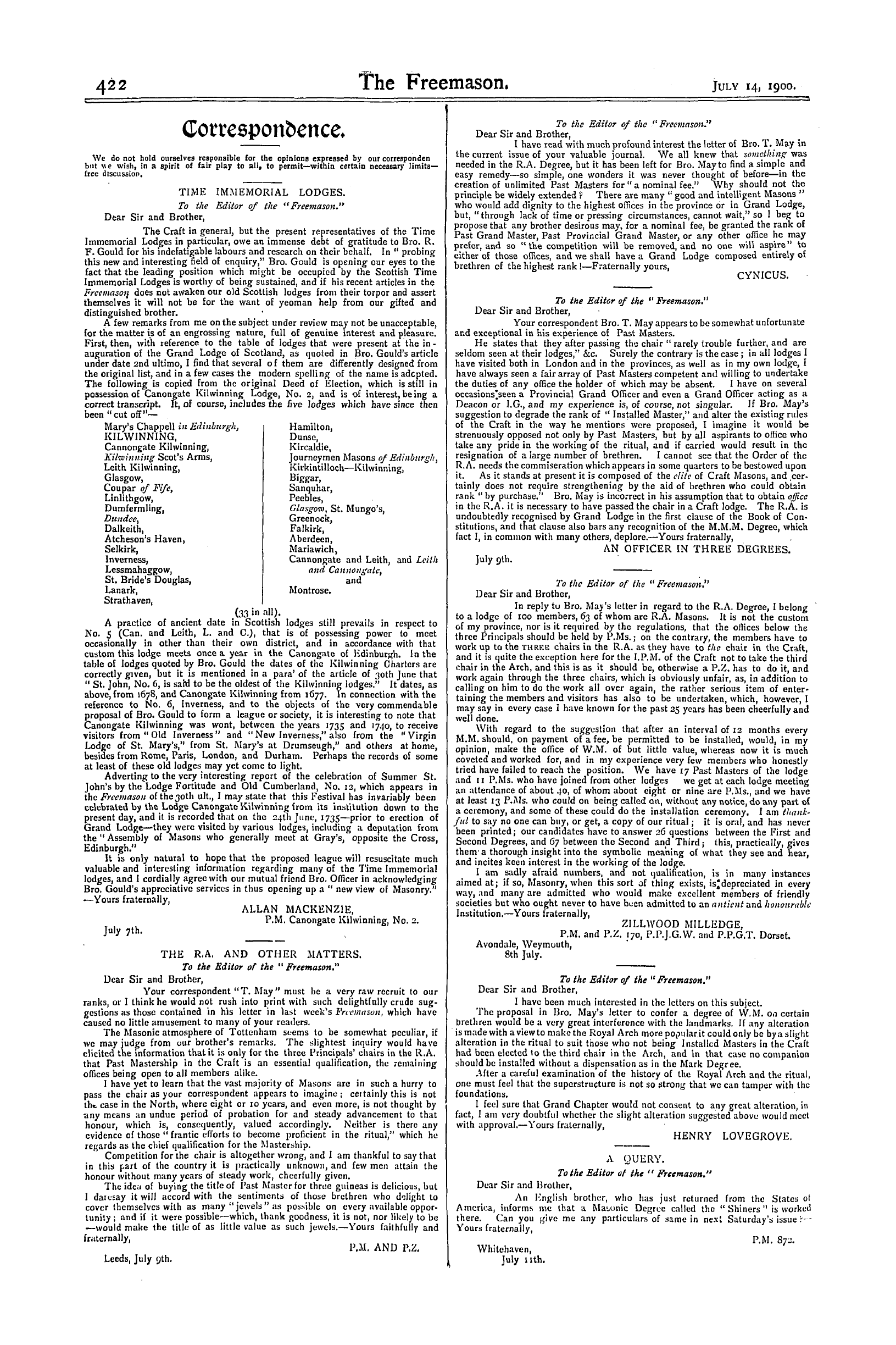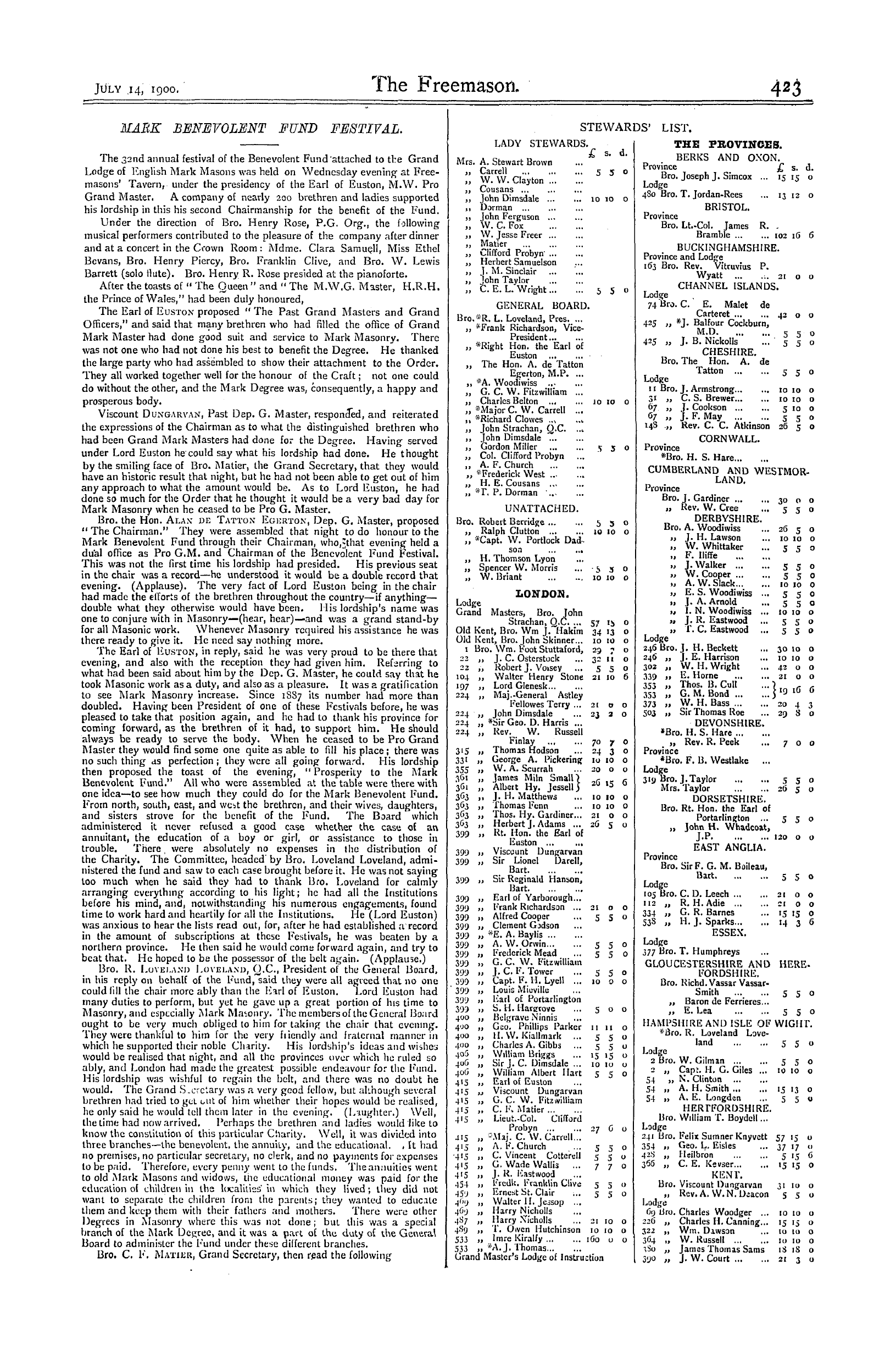-
Articles/Ads
Article Science, Art, and the Drama. Page 1 of 1 Article Science, Art, and the Drama. Page 1 of 1 Article ROYAL ITALIAN OPERA, COVENT GARDEN. Page 1 of 1
Note: This text has been automatically extracted via Optical Character Recognition (OCR) software.
Science, Art, And The Drama.
Science , Art , and the Drama .
REMARKABLE HAIL-STORMS . The damage done by hail in this country is very trifling compared with the ruin it sometimes works in other countries . To our insular climate , which is free from extremes of heat and cold , is due our comparative immunity from disastrous hail-storms , hail being , so far as is known , produced by the mixing of warm and cold layers of the atmosphere ; the greater the difference of their temperature , the larger the hail which falls , and the more
violent the thunder-storms and gales which accompany its formation . On the Continent there are in active operation numerous hail insurance offices , which indemnify farmers and the cultivators of vineyards and orchards against losses caused by hail . This kind of insurance business is hardly required with us . In Wurtemberg during 60 years hail fell on 13 days yearly , on the average affecting one per cent , of the cultivated land , and
doing damage to the extent of £ 120 , 000 . It is credibly stated that in the Orkneys hailstones as big as goose eggs have been known to fall ; each was , however , a mass of small ones which had come together during their descent ] More exact details are obtainable of the size of hailstones which have fallen within recent years . Near Leeds , on 30 th June , 18 S 3 , there was a heavy tall of hailstone , which took the shape of irregular blocks of hard
colourless , transparent ice , some of which measured an inch in length and contained numerous air-bubbles . At Chepstow , 5 th April , 1 SS 7 , there occurred a remarkable shower of conical , spiked , and very irregularlyshaped hailstones , of which no two were alike . Some were composed of two , three , or more , joined together . The largest measured were fourtenths of an inch long and three-tenths of an inch broad . About the
same time similarly shaped stones fell near Kelso . A hail-storm at Liverpool , 2 nd June , 1 SS 9 , was taken considerable notice of at the time in scientific papers . The hailstones were of irregular and very curious shapes ; some measured as much as an inch and three-quarters across . A number which fell on grass took an hour and a half to melt , though the temperature of the air was 65 degrees Fahrenheit . The residue left , when
the stones were melted , was found to contain minute plant-spores . Hailstones , as large as half-an-inch in diameter , rarely occur in the London district . On the 24 th May , 1 S 91 , some were there observed which slightly exceeded that size . These hailstones , which are considered large in this country , are insignificant by the side of thoss which frequently fall in other parts of the world . In September , 1856 , a strip of country , near Florence ,
was ruined , during a violent thunderstorm , by hailstones , which weighed from 120 Z . to 140 Z . At Tomsk , in Siberia , hailstones as big as eggs fell on the igth July , 1 SS 3 . Two women were struck on the head and killed , and many birds and animals were killed . In Iowa , U . S . America , on 7 th August , 1 SS 3 , a hail-storm passed through three counties , and over its track , which was tour miles wide , all vegetation was destroyed , a woman was
killed , and many people were injured . The hail fell in many places to the depth of live feet , and trains were blocked . During the successive showers of hail , which fell at Graz , in Austria , on 21 st August , 1890 , at five , six , and seven p . m ., the hailstones ranged from one-and-a-half to two-and-ahalf inches in diameter , and formed , in soma places , a compact mass of ice three feet thick . In October , 1892 , a large district in New South Wales
was visited by a very destructive hail-stonn . Some of the hailstones measured six-and-a-half inches in circumference , and these were not the largest that fell . These monsters were triangular , and irregular in shape ; and the terrific force of their fall may be estimated from the fact that they dented , and even perforated , galvanized iron roofs . In one sheet of iron roofing 30 holes were counted ; and in another more than 60 . The gale
which accompanied and aided their destructive work was strong enough to snap , clean off , great trees 12 feet in circumference . The most destructive liail-stortns on record have occurred in India . There is a legendary story to the effect that in the reign of Tippoo Sahib there fell , at Seringapatam , a hailstone as big as an elephant , which took three days to melt ! The possible germ of truth in this yarn may have been the falling of a number
of large hailstones , in succession , into a hole , where they may have frozen into one mass . Big hailstones are never smooth , round balls , but irregularly shaped blocks of ice , frequently studded with sharp crystals , and it may be imagined how dangerous to man and beast , unprovided with shelter , must be such jagged missiles , propelled by a fiercs wind . Coloured hail stones have sometimes been observed . On 7 th May , 1 SS 5 ,
near Castlewellan , in Ireland , during a shower of hail , some of the stones were decidedly red , while the rest were white as usual . The colour was not merely superficial , but pervaded the substance of the stone , and on melting , stained the lingers of the observer . In Minsk , Prussia , on 14 th June , 1 SS 0 , during a shower of hailstones , which showed great variety of form , some being flattened , perforated , and ring-like , a considerable proportion were
coloured pale red , and others pale blue . Similar coloured hailstones have been observed in other places ; and a German meteorologist who examined some of these as : tibds their colour to the presence of salts of cobalt and nickel , and thinks that this favours the belief , that such hailstone ; do not owe their origin to our atmosphere at all , but have come into it from the regions of space . At a meeting ol the Meteorological Society in the Institution of
Civil Engineers , Mr . VV . Marriott , F . R . Met . Soc , gave an account of the thunder and hail-storms which occuired over England and the South of Sco land on Stli July , 189 , 3 . Thunder storms were very numerous on that day , and , in many instances , were accompanied by terrific haii-storms , and squalls of wind . It was during one of these squalls that a pleasure boat was capsized olT Skegness , 29 persons being drowned , About noon , a
thunder storm , accompanied by heavy hail and a violent squall of wind , pis-. edover Dumfries and along the valley of the Nith . Many of the hailstonts measured from an inch to an inch and a half in length . At the tame hour , a similar storm occurred at Peterborough . From about two until lu p . m . there was a succession of thunder storms over the North-east of England and South-east of Scotland , and at many placss , it was reported ,
lhat the thunder storms were continuous for nine hours . Two storms were remarkable for the immense hailstones which fell during their prevalence over Harrogate and Richmond , in Yorkshire . The hailstones were four or live inches 111 circumference , and some as much as three inches in diameter . Gnat damage was done by the . e stones , all windows and glass , facing the
direction from which the storm came , being broken . It is computed , that within a radius ol live miles of Harrogate , a hundred thousand panes of glass weie broken , the extent of the damage being estimated at about £ j OV > . The thunder storms in the northern part of the county travelled generally in a norlh-iioith-weitirly direction at the rate of about i * o miles
Science, Art, And The Drama.
an hour . They appear to have taken the path of'least resistan ce , and conse quently passed over low ground and along river valleys and the sea coast Several storms seem to have followed each other along the sam e track .
STATE OF PAINTING UNDER MARY I .
The reign of Mary , though shorter even than that of her brother , makes a much more considerable figure in the annals of painting . It was distinguished by more good painters than one ; the principal was Sir Antonio More—1525—1581 . He was a native of Utrecht , and scholar of John Schorel , but seems to have studied the manner of Holbein , to which he
approached nearer than to the freedom of design in the works of the great masters that he saw at Rome . Like Holbein , he was a close imitator of nature , but did not arrive at his extreme delicacy of finishing ; on the contrary , Antonio sometimes struck into a bold and masculine style . In 1592 he drew Philip II ., and was recommended by Cardinal Granville to Charles V ., who sent him to
Portugal , where he painted John III ., the king , Catherine of Austria , his queen , and the Infanta Mary , first wife of Philip . For these three pictures he received 600 ducats , besides a gold chain of ioco florins and other presents . He had 100 ducats for his common portraits . But still ampler rewards were bestowed on him when sent into England to draw the picture of Oueen Mary , the intended bride of Philip . They gave him . £ 100 , agold as to
chain , and a pension of ^ 100 a quarter painter their majesties . Sandast says Queen Mary was very handsome . It is certain that the drawing of her ( when about 16 ) by Holbein , at Kensington , is not disagreeable , though her later pictures have all a stern , hard-favoured countenance . He remained in England during the reign of Mary , and was much employed , but having neglected , as is frequent , to write the names on the portraits he
drew , most of them have lost part oi their value by our ignorance of the persons represented . On the death of Mary , More followed Philip into Spain , where he was indulged in so much familiarity , that one day the king slapping him pretty soundly on the shoulder , More returned the sport with hand-stick—a strange liberty to be taken with a Spanish monarch ! A grandee interposed for his pardon , and he was permitted to retire to the
Netherlands . Philip , for once forgetting majesty in his love of the arts , dispatched a messenger to recall him before he had finished his journey , but the painter , sensible of the danger he had escaped , modestly excused himself . The story says Philip bestowed noble presents and places on his children . ( To be continued . )
Royal Italian Opera, Covent Garden.
ROYAL ITALIAN OPERA , COVENT GARDEN .
We again notice some of the operas performed during the past weeksthrough more pressing matters , we are much in arrear . " Carmen " has been presented , and when we state that Calve filled the title rule , we may imagine the possibilities of this great character ( great in its varied moods , its play of passion , and its strength of " coquetry " ) , when entrusted to this accomplished singer and actress . Let it suffice that the prima donna has
returned to us , with her marvellous qualities of greatness undiminished , and that the performance was worthy of Calve . " Lohengrin " was partly a disappointment . Teriiina was beautifully vocal as " Elsa , " and in the first act looked the part , but in the second her ill-fitting , tasteless bridal dress spoilt all suggestions of girlishness . Nothing need be said as to her acting ; it was irreproachable . The new Lohengrin , Herr Slezak , is ,
perhaps , the most youthful-looking Knight of the Swan who has ever appeared at Covent Garden . He had a good presence , and a good voice —not one to become enthusiastic over , but yet one which has great possibilities . He is young , and full of intelligence . He acts with dignity , and a fair amount of discretion . Herr Bertram ' s Telramund is not of a high order , nor is the Ortrud of Mme . Louise Homer . Her voice was harsh ,
and her manner undramatic . Herrcn Blass and Muhlmann rendered fair service as the King and the Herald . Mottle conducted in an uninspired sort of way , and the performance , as a whole , lacked cohesion and interest . " Pagliacci " and " Cavalleria Rusticana" were given so long a rest , during the latter part of the season of 18 99 , that they came forth , lately , with some degree of freshness . The heartiness with which both works were received
at any rate justified their repetition , while the excellence of each representation did something , it may be , to enhance their popularity . " Pagliacci " introduced the audience to a new prima donna , Mile . Schell , who , though she has seen but 20 summers , has already gathered a plentiful sheaf of laurels in Munich and other German cities . This occasion saw not only her introduction to a London audience but also her first attempt at
Italian opera in its native language . Fraulein Scheff was decidedly successful , though her make-up was not particularly Italian . Her voice is a fresh and flexible soprano , her dramatic gifts are considerable , and she is a remarkably pretty girl . Her impersonation of Kedda was exceedingly neat and artistic , and her future is interesting and full of promise . We camwt do more than record the good work done by M . Salignac as Canio , and
include Signor Scolti ( lonio ) , isignor Daddi ( Bepps ) , and M . Declery ( Silvio ) in general commendation of a thoroughly acceptable performance . In Mascagni's opera the great attraction was , of course , Mme . Calve ' s Santuzza . There is no need , however , to dwell upon its excellence . Vet a word must be said in praise of Mr . Josjph O Mara , who played the part o ( Turridu with ease and energy ; while Mme . Homer , as Lola , was pathetic and powerful . Mile . Bouermeister and M . Benstiada completed a cap ital cast .
GENERAL NOTES . The Baroness Christiana Valmar , who made a very successful appliance at the Palace Theatre , has been exclusively engaged at the 'l'ivoli . The Baroness has a repertoire of some 25 songs to select ' from , and will aM introduce her dances . * * * * May is usually one of the bast months of the trouling season on tltf Thames , but it must hi said that the angler who has only a fixed and
limited time at his command , stands a comparatively small chance of taking a trout , even under favourable conditions . Now and again , success way possibly attend him , but m . uf of the lish fall to those , who not only ki "'* how and where , to catch them , but are able to devote much time to the pursuit . To be successful the home of ths fish , from which he wanders b jl
little , rmis : be discovered , and his regular meal timss ascertained , ivJ'ich will be indicated by the commotion caused by his presence among the bleak and minows , and it is only at such times that the angler stands a chancs * success . The larger trout are caught live-baiting or spinning , and it is very rare , indeed , that the old stagers rise to a lly .
Note: This text has been automatically extracted via Optical Character Recognition (OCR) software.
Science, Art, And The Drama.
Science , Art , and the Drama .
REMARKABLE HAIL-STORMS . The damage done by hail in this country is very trifling compared with the ruin it sometimes works in other countries . To our insular climate , which is free from extremes of heat and cold , is due our comparative immunity from disastrous hail-storms , hail being , so far as is known , produced by the mixing of warm and cold layers of the atmosphere ; the greater the difference of their temperature , the larger the hail which falls , and the more
violent the thunder-storms and gales which accompany its formation . On the Continent there are in active operation numerous hail insurance offices , which indemnify farmers and the cultivators of vineyards and orchards against losses caused by hail . This kind of insurance business is hardly required with us . In Wurtemberg during 60 years hail fell on 13 days yearly , on the average affecting one per cent , of the cultivated land , and
doing damage to the extent of £ 120 , 000 . It is credibly stated that in the Orkneys hailstones as big as goose eggs have been known to fall ; each was , however , a mass of small ones which had come together during their descent ] More exact details are obtainable of the size of hailstones which have fallen within recent years . Near Leeds , on 30 th June , 18 S 3 , there was a heavy tall of hailstone , which took the shape of irregular blocks of hard
colourless , transparent ice , some of which measured an inch in length and contained numerous air-bubbles . At Chepstow , 5 th April , 1 SS 7 , there occurred a remarkable shower of conical , spiked , and very irregularlyshaped hailstones , of which no two were alike . Some were composed of two , three , or more , joined together . The largest measured were fourtenths of an inch long and three-tenths of an inch broad . About the
same time similarly shaped stones fell near Kelso . A hail-storm at Liverpool , 2 nd June , 1 SS 9 , was taken considerable notice of at the time in scientific papers . The hailstones were of irregular and very curious shapes ; some measured as much as an inch and three-quarters across . A number which fell on grass took an hour and a half to melt , though the temperature of the air was 65 degrees Fahrenheit . The residue left , when
the stones were melted , was found to contain minute plant-spores . Hailstones , as large as half-an-inch in diameter , rarely occur in the London district . On the 24 th May , 1 S 91 , some were there observed which slightly exceeded that size . These hailstones , which are considered large in this country , are insignificant by the side of thoss which frequently fall in other parts of the world . In September , 1856 , a strip of country , near Florence ,
was ruined , during a violent thunderstorm , by hailstones , which weighed from 120 Z . to 140 Z . At Tomsk , in Siberia , hailstones as big as eggs fell on the igth July , 1 SS 3 . Two women were struck on the head and killed , and many birds and animals were killed . In Iowa , U . S . America , on 7 th August , 1 SS 3 , a hail-storm passed through three counties , and over its track , which was tour miles wide , all vegetation was destroyed , a woman was
killed , and many people were injured . The hail fell in many places to the depth of live feet , and trains were blocked . During the successive showers of hail , which fell at Graz , in Austria , on 21 st August , 1890 , at five , six , and seven p . m ., the hailstones ranged from one-and-a-half to two-and-ahalf inches in diameter , and formed , in soma places , a compact mass of ice three feet thick . In October , 1892 , a large district in New South Wales
was visited by a very destructive hail-stonn . Some of the hailstones measured six-and-a-half inches in circumference , and these were not the largest that fell . These monsters were triangular , and irregular in shape ; and the terrific force of their fall may be estimated from the fact that they dented , and even perforated , galvanized iron roofs . In one sheet of iron roofing 30 holes were counted ; and in another more than 60 . The gale
which accompanied and aided their destructive work was strong enough to snap , clean off , great trees 12 feet in circumference . The most destructive liail-stortns on record have occurred in India . There is a legendary story to the effect that in the reign of Tippoo Sahib there fell , at Seringapatam , a hailstone as big as an elephant , which took three days to melt ! The possible germ of truth in this yarn may have been the falling of a number
of large hailstones , in succession , into a hole , where they may have frozen into one mass . Big hailstones are never smooth , round balls , but irregularly shaped blocks of ice , frequently studded with sharp crystals , and it may be imagined how dangerous to man and beast , unprovided with shelter , must be such jagged missiles , propelled by a fiercs wind . Coloured hail stones have sometimes been observed . On 7 th May , 1 SS 5 ,
near Castlewellan , in Ireland , during a shower of hail , some of the stones were decidedly red , while the rest were white as usual . The colour was not merely superficial , but pervaded the substance of the stone , and on melting , stained the lingers of the observer . In Minsk , Prussia , on 14 th June , 1 SS 0 , during a shower of hailstones , which showed great variety of form , some being flattened , perforated , and ring-like , a considerable proportion were
coloured pale red , and others pale blue . Similar coloured hailstones have been observed in other places ; and a German meteorologist who examined some of these as : tibds their colour to the presence of salts of cobalt and nickel , and thinks that this favours the belief , that such hailstone ; do not owe their origin to our atmosphere at all , but have come into it from the regions of space . At a meeting ol the Meteorological Society in the Institution of
Civil Engineers , Mr . VV . Marriott , F . R . Met . Soc , gave an account of the thunder and hail-storms which occuired over England and the South of Sco land on Stli July , 189 , 3 . Thunder storms were very numerous on that day , and , in many instances , were accompanied by terrific haii-storms , and squalls of wind . It was during one of these squalls that a pleasure boat was capsized olT Skegness , 29 persons being drowned , About noon , a
thunder storm , accompanied by heavy hail and a violent squall of wind , pis-. edover Dumfries and along the valley of the Nith . Many of the hailstonts measured from an inch to an inch and a half in length . At the tame hour , a similar storm occurred at Peterborough . From about two until lu p . m . there was a succession of thunder storms over the North-east of England and South-east of Scotland , and at many placss , it was reported ,
lhat the thunder storms were continuous for nine hours . Two storms were remarkable for the immense hailstones which fell during their prevalence over Harrogate and Richmond , in Yorkshire . The hailstones were four or live inches 111 circumference , and some as much as three inches in diameter . Gnat damage was done by the . e stones , all windows and glass , facing the
direction from which the storm came , being broken . It is computed , that within a radius ol live miles of Harrogate , a hundred thousand panes of glass weie broken , the extent of the damage being estimated at about £ j OV > . The thunder storms in the northern part of the county travelled generally in a norlh-iioith-weitirly direction at the rate of about i * o miles
Science, Art, And The Drama.
an hour . They appear to have taken the path of'least resistan ce , and conse quently passed over low ground and along river valleys and the sea coast Several storms seem to have followed each other along the sam e track .
STATE OF PAINTING UNDER MARY I .
The reign of Mary , though shorter even than that of her brother , makes a much more considerable figure in the annals of painting . It was distinguished by more good painters than one ; the principal was Sir Antonio More—1525—1581 . He was a native of Utrecht , and scholar of John Schorel , but seems to have studied the manner of Holbein , to which he
approached nearer than to the freedom of design in the works of the great masters that he saw at Rome . Like Holbein , he was a close imitator of nature , but did not arrive at his extreme delicacy of finishing ; on the contrary , Antonio sometimes struck into a bold and masculine style . In 1592 he drew Philip II ., and was recommended by Cardinal Granville to Charles V ., who sent him to
Portugal , where he painted John III ., the king , Catherine of Austria , his queen , and the Infanta Mary , first wife of Philip . For these three pictures he received 600 ducats , besides a gold chain of ioco florins and other presents . He had 100 ducats for his common portraits . But still ampler rewards were bestowed on him when sent into England to draw the picture of Oueen Mary , the intended bride of Philip . They gave him . £ 100 , agold as to
chain , and a pension of ^ 100 a quarter painter their majesties . Sandast says Queen Mary was very handsome . It is certain that the drawing of her ( when about 16 ) by Holbein , at Kensington , is not disagreeable , though her later pictures have all a stern , hard-favoured countenance . He remained in England during the reign of Mary , and was much employed , but having neglected , as is frequent , to write the names on the portraits he
drew , most of them have lost part oi their value by our ignorance of the persons represented . On the death of Mary , More followed Philip into Spain , where he was indulged in so much familiarity , that one day the king slapping him pretty soundly on the shoulder , More returned the sport with hand-stick—a strange liberty to be taken with a Spanish monarch ! A grandee interposed for his pardon , and he was permitted to retire to the
Netherlands . Philip , for once forgetting majesty in his love of the arts , dispatched a messenger to recall him before he had finished his journey , but the painter , sensible of the danger he had escaped , modestly excused himself . The story says Philip bestowed noble presents and places on his children . ( To be continued . )
Royal Italian Opera, Covent Garden.
ROYAL ITALIAN OPERA , COVENT GARDEN .
We again notice some of the operas performed during the past weeksthrough more pressing matters , we are much in arrear . " Carmen " has been presented , and when we state that Calve filled the title rule , we may imagine the possibilities of this great character ( great in its varied moods , its play of passion , and its strength of " coquetry " ) , when entrusted to this accomplished singer and actress . Let it suffice that the prima donna has
returned to us , with her marvellous qualities of greatness undiminished , and that the performance was worthy of Calve . " Lohengrin " was partly a disappointment . Teriiina was beautifully vocal as " Elsa , " and in the first act looked the part , but in the second her ill-fitting , tasteless bridal dress spoilt all suggestions of girlishness . Nothing need be said as to her acting ; it was irreproachable . The new Lohengrin , Herr Slezak , is ,
perhaps , the most youthful-looking Knight of the Swan who has ever appeared at Covent Garden . He had a good presence , and a good voice —not one to become enthusiastic over , but yet one which has great possibilities . He is young , and full of intelligence . He acts with dignity , and a fair amount of discretion . Herr Bertram ' s Telramund is not of a high order , nor is the Ortrud of Mme . Louise Homer . Her voice was harsh ,
and her manner undramatic . Herrcn Blass and Muhlmann rendered fair service as the King and the Herald . Mottle conducted in an uninspired sort of way , and the performance , as a whole , lacked cohesion and interest . " Pagliacci " and " Cavalleria Rusticana" were given so long a rest , during the latter part of the season of 18 99 , that they came forth , lately , with some degree of freshness . The heartiness with which both works were received
at any rate justified their repetition , while the excellence of each representation did something , it may be , to enhance their popularity . " Pagliacci " introduced the audience to a new prima donna , Mile . Schell , who , though she has seen but 20 summers , has already gathered a plentiful sheaf of laurels in Munich and other German cities . This occasion saw not only her introduction to a London audience but also her first attempt at
Italian opera in its native language . Fraulein Scheff was decidedly successful , though her make-up was not particularly Italian . Her voice is a fresh and flexible soprano , her dramatic gifts are considerable , and she is a remarkably pretty girl . Her impersonation of Kedda was exceedingly neat and artistic , and her future is interesting and full of promise . We camwt do more than record the good work done by M . Salignac as Canio , and
include Signor Scolti ( lonio ) , isignor Daddi ( Bepps ) , and M . Declery ( Silvio ) in general commendation of a thoroughly acceptable performance . In Mascagni's opera the great attraction was , of course , Mme . Calve ' s Santuzza . There is no need , however , to dwell upon its excellence . Vet a word must be said in praise of Mr . Josjph O Mara , who played the part o ( Turridu with ease and energy ; while Mme . Homer , as Lola , was pathetic and powerful . Mile . Bouermeister and M . Benstiada completed a cap ital cast .
GENERAL NOTES . The Baroness Christiana Valmar , who made a very successful appliance at the Palace Theatre , has been exclusively engaged at the 'l'ivoli . The Baroness has a repertoire of some 25 songs to select ' from , and will aM introduce her dances . * * * * May is usually one of the bast months of the trouling season on tltf Thames , but it must hi said that the angler who has only a fixed and
limited time at his command , stands a comparatively small chance of taking a trout , even under favourable conditions . Now and again , success way possibly attend him , but m . uf of the lish fall to those , who not only ki "'* how and where , to catch them , but are able to devote much time to the pursuit . To be successful the home of ths fish , from which he wanders b jl
little , rmis : be discovered , and his regular meal timss ascertained , ivJ'ich will be indicated by the commotion caused by his presence among the bleak and minows , and it is only at such times that the angler stands a chancs * success . The larger trout are caught live-baiting or spinning , and it is very rare , indeed , that the old stagers rise to a lly .


